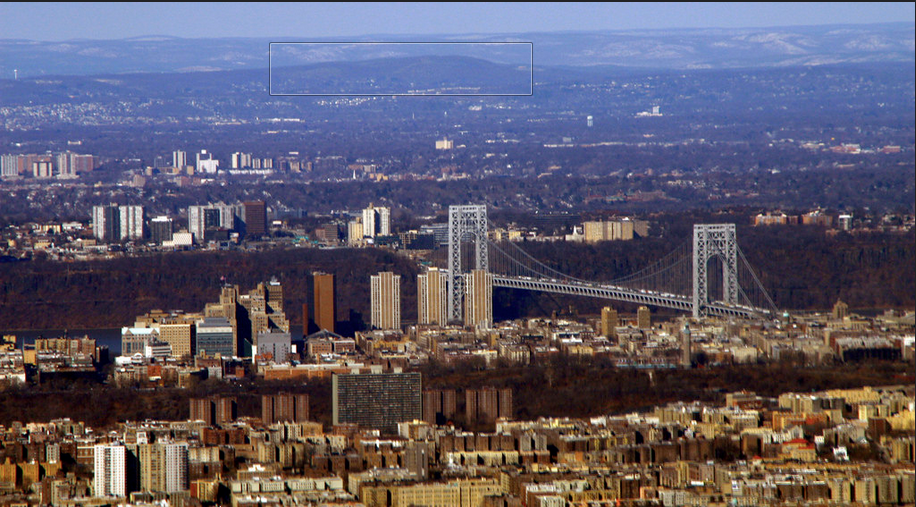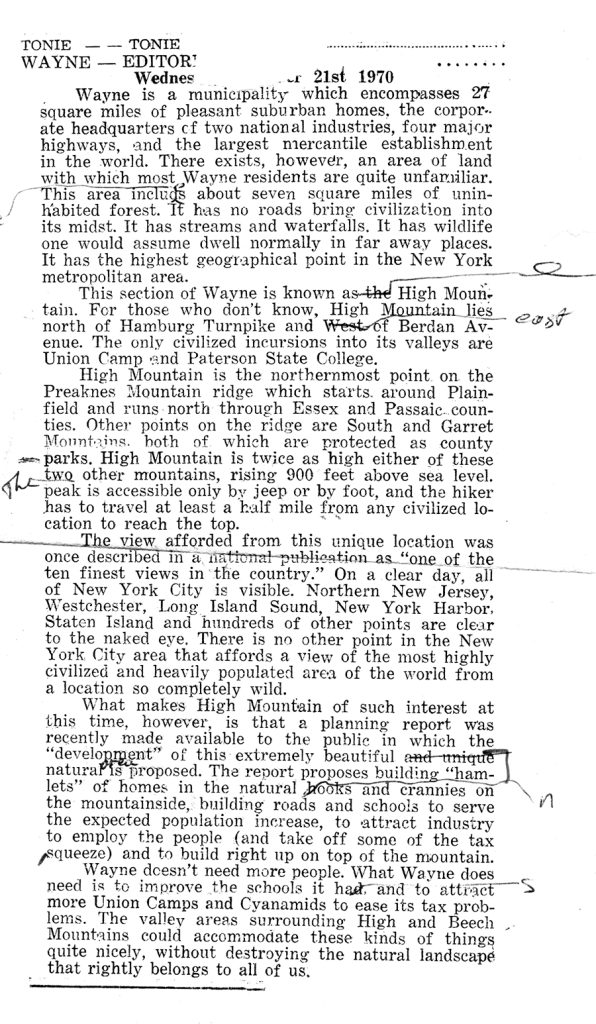 I’ve long thought that the most consequential thing I’ve ever done was write a newspaper editorial that helped stop development atop the highest wooded hilltop overlooking the New York metro. The hill is called High Mountain, and it is now home to the High Mountain Park Preserve in Wayne, New Jersey. That’s it above, highlighted by a rectangle on a shot I took from a passenger plane on approach to LaGuardia in 2008.
I’ve long thought that the most consequential thing I’ve ever done was write a newspaper editorial that helped stop development atop the highest wooded hilltop overlooking the New York metro. The hill is called High Mountain, and it is now home to the High Mountain Park Preserve in Wayne, New Jersey. That’s it above, highlighted by a rectangle on a shot I took from a passenger plane on approach to LaGuardia in 2008.
The year was 1970, and I was a 23-year-old reporter for a suburban daily called Wayne Today (which may still exist). One day, while at the police station picking up copies of the previous day’s reports, I found a detailed plan to develop the top of High Mountain, and decided to pay the place a visit. So I took a fun hike through thick woods and a din of screaming cicadas (Brood X, I gather—the same one that inspired Bob Dylan’s “Day of the Locust”) to a rocky clearing at the crest, and immediately decided the mountain was a much better place for a park than for the office building specified in the plan.
As it happened there was also a need for an editorial soon after that, and Jerry Fuchs, who usually wrote our editorials, wasn’t available. So I came off the bench and wrote this:

That was a draft proof of the piece.* I ran across it today while cleaning old papers from a file cabinet in my garage. I doubt anybody has the final printed piece, and I’m amazed that the proof exists.
I left for another paper after that, and didn’t keep up with Wayne news, beyond hearing that my editorial derailed the development plan. No doubt activists of various kinds were behind the eventual preservation of the mountain. But it’s nice to know there is some small proof I had something to do with that.
*Additional history: Wayne Today published in those days using old-fashioned letterpress techniques. Type was set in lead by skilled operators on Linotype machines. Each line was a “slug,” and every written piece was a pile of slugs arranged in a frame, inked with a roller and then proofed by another roller that printed on blank paper. That’s what we marked up (as you see above) for the Linotype operators, who would create replacement slugs, give them to the page composers in layout, who could read upside down and backwards as they arranged everything in what was called a forme. The layout guys (they were all guys) then embossed each page into a damp papier-mâché sheet, which would serve as a mold for a half-cylinder of hot lead. Half-cylinders wrapped around giant rollers inked each rotation by other rollers did the printing. Other machines after that cut, stacked and folded the pages that ended up as newspapers at the end of the line. So the whole process went like this: reporter->Linotype operator->editor->Linotype operator->page composer->stereotype operator->printer. Ancestors of robotics eventually replaced all of it not long after I left (and the press burned down). Now in the U.S. exemplars of big-J journalism (New York Times, Washington Post) are tarred by the President as “fake news,” and millions believe him. My, how times change.
More High Mountain links:
Save
Leave a Reply